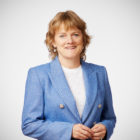University of California, San Francisco – Pride Hall
San Francisco, California, United States

FAIA, LEED AP BD+C
Managing Partner
San Francisco, Seattle

Carrie leverages her expertise in design, management and technology to deliver sustainable and impactful architecture. With more than three decades of experience, Carrie applies SOM’s interdisciplinary and research-based approach to bring groundbreaking designs to life through a variety of delivery methods and across typologies.
Her impact can be felt across several markets, with a particular emphasis on science and academic work led out of the West Coast studios. She navigates complex delivery methods including CMAR, design-build, progressive design build, and public-private partnerships–to create buildings that enable institutions to grow and adapt over time. Most recently, she completed the largest new building on the Rice University historic campus, a research and education building dedicated to public health for the City and County of San Francisco, and the new Grimes Engineering Center at UC Berkeley that will act as a learning tool itself. She partnered with the University of California, Merced for nearly two decades, enabling the newest campus in the UC system to become the first carbon-neutral public university in the country.
When diverse perspectives come together, great ideas emerge. That’s one of the reasons why we work hard to build teams that represent a broad range of backgrounds.
Previously, she managed the expansion of Moscone into the lowest carbon-emissions-per-visitor convention center in North America, the mixed-use development that houses the city of San Francisco’s municipal offices, and the transformation of Seattle-Tacoma International Airport’s International Arrivals Facility into a welcoming, soaring space for new arrivals to the region.
Carrie serves as one third of the firm’s first all-female Executive Committee and was named an AIA Fellow in 2013. An advocate for building partnerships and long term relationships with W/MBEs and small businesses, Carrie is committed to mentorship and increasing diversity and opportunity across the professions.
San Francisco, California, United States
Seattle, Washington, United States
Berkeley, California, United States
Houston, Texas, United States
San Francisco, California, United States
Los Angeles, California, United States
Goleta, California, United States
Stanford, California, United States
Storrs, Connecticut, United States
01/